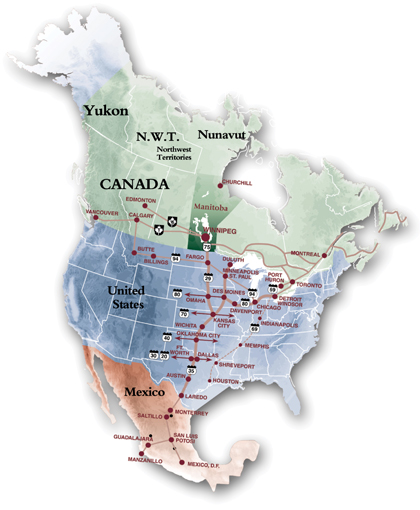Manitoba's Strategic Advantages
Central Location and Solid Transportation Infrastructure
Manitoba’s position at the heart of North America makes it a key part of the Mid-continent Trade Corridor, connecting Canada to a central North American market of 100 million people.

Located in the heart of North America, Manitoba has expedient access to all major North American markets, and equal access to all major North American seaports for global shipping. Major Canadian markets can be reached in three days or less by land and three hours or less by air. The most distant US markets and seaports can be reached in five days by land and six hours by air.
Manitoba has:
- Three rail links to the United States, with connections allowing shipment throughout North America.
- Rail yards able to handle over 5,500 cars per day, and intermodal terminals with capacity to process more than 200,000 containers per year.
- Four of the top 100 for-hire carriers in Canada are headquartered in Manitoba. On average, about 1,200 trucks cross the Manitoba–U.S. border at Emerson every day. Provincial Highways 75 and 59 lead one hour south to link with the U.S. National Highway System via North Dakota and Minnesota. Highway 75 is twinned to the U.S. border. Goods can be shipped by truck from Canada to Mexico and all points between via US Interstate highways I-29 and I-35. Major border crossings to the U.S. are open 24 hours per day, and an automated border crossing at Emerson, Manitoba, enables standard wait times of 10 minutes or less even as it is the second busiest land border crossing in Western Canada, and the seventh busiest nationally.
- A conveniently located 24-hour international airport that serves as an important overnight cargo hub for FedEx, Purolator, UPS, and Cargojet Airlines. The international airport also includes a direct connection to Mexico via the Mid-continent Trade Corridor.
Mid-continent Trade Corridor
Through a system of connecting highways and rail routes, the Mid-continent Trade Corridor provides seamless and efficient transportation linking major commercial centres in the Canadian and American Midwest, through the Southwest, and deep into Mexico. Key cities along this corridor include Winnipeg, Minneapolis, Kansas City, Oklahoma City, Dallas-Fort Worth, Austin, San Antonio, Monterrey, Guadalajara and Mexico City.
Intermodal in nature, the Corridor allows cost-effective and safe movement of goods and people, minimizing both travel costs and time.
Transit Time from Winnipeg
| Modes of Transport | |||||
| From Winnipeg to: | Truckload (days) | Less-Than Truckload (days) |
Rail Carload (days) | Inter-Modal (days) | Air (hours) |
| Vancouver | 3 | 3 | 8 | 3 | 3 |
| Toronto | 3 | 3 | 7 | 2 | 2 1/4 |
| Montreal | 3 | 3 | 7 | 3 | 3 1/2 |
| Halifax | 6 | 6 | 7 | 5 | 5 1/4 |
| Calgary | 2 | 2 | 4 | 2 | 2 |
| Edmonton | 2 | 2 | 4 | 2 | 2 |
| Portland | 3 | 4 | 7 | 7 | 5 |
| Los Angeles | 5 | 6 | 9 | 9 | 6 |
| Kansas City | 2 | 3 | 5 | 5 | 3 1/4 |
| Houston | 3 | 4 | 6 | 6 | 5 |
| Denver | 2 | 3 | 5 | 5 | 4 |
| Minneapolis | 1 | 2 | 3 | 3 | 1 1/2 |
| Chicago | 2 | 3 | 4 | 2 | 2 |
| Cincinnati | 2 | 3 | 4 | 4 | 4 |
| Pittsburgh | 2 | 3 | 7 | 7 | 4 |
| Boston | 3 | 4 | 10 | 10 | 5 |
| New York | 3 | 4 | 10 | 8 | 4 1/4 |
| Miami | 5 | 6 | 12 | 10 | 6 |


